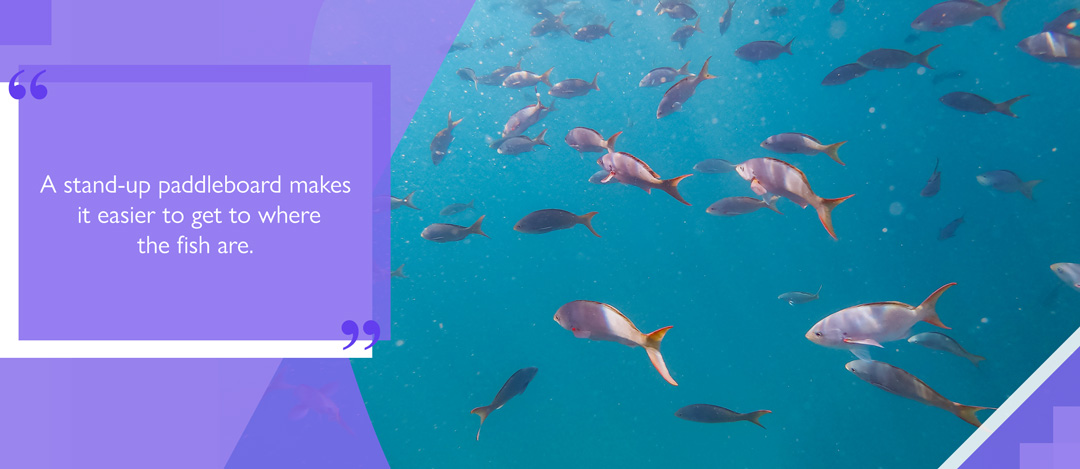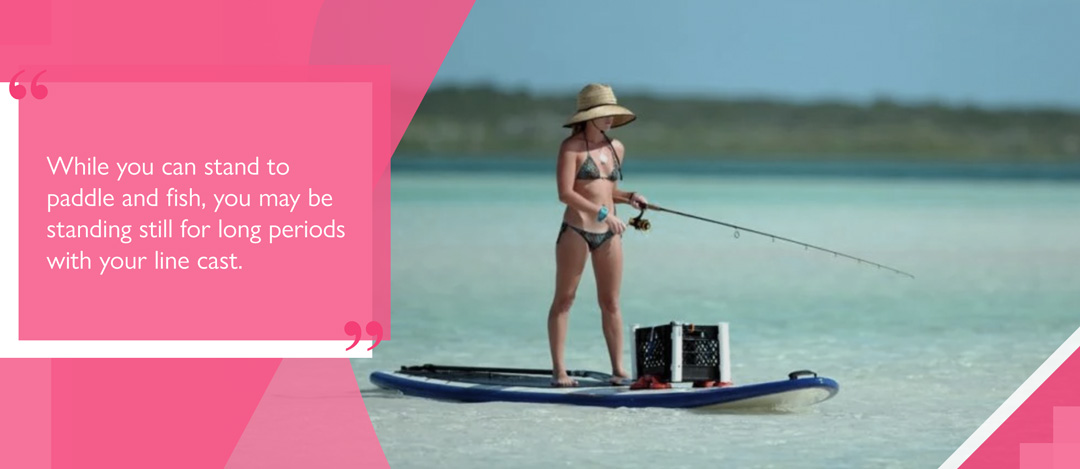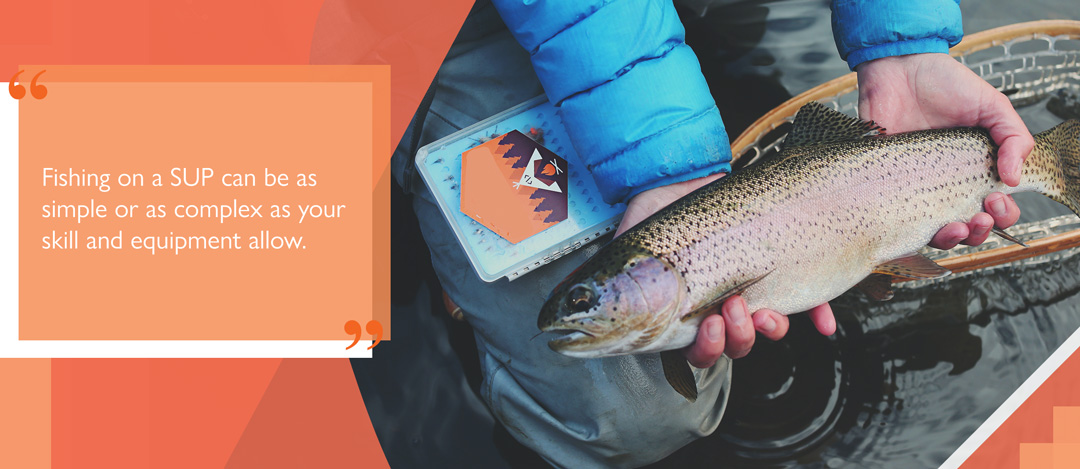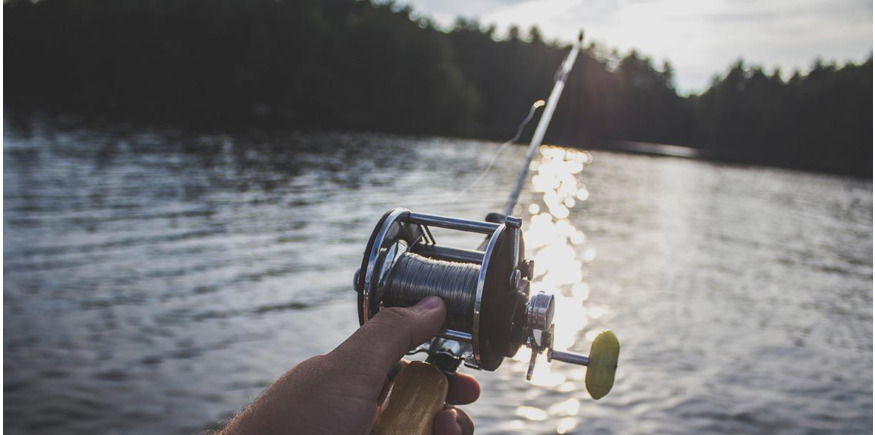Whether you intend to catch and release, or you’re fishing for your supper, there are many reasons to opt for a SUP as a serious fishing vessel.
In this post, we’ll take a brief dive into the world of SUP fishing: the type of board, planning a trip, things to consider, as well as some of the gear.
As with our other guides to specialist activities, what follows is a basic introduction for beginners. We love getting out on the water, in all its forms, but we’re not professional anglers. If you try it and feel it may be for you, or want in depth advice on technique, we’d urge you to get out there and talk to the many helpful experts in the SUP and fishing communities — either online or in person.
Choosing to use a SUP for fishing
Many fishing enthusiasts prefer to use a SUP, rather than a kayak or boat, because it offers a few distinct advantages:
Stealth
A SUP is not powered by a motor and is also not large. It can quietly drift into place aided by a paddle. Unlike larger vessels, the approach of a SUP is also less likely to disturb nearby fish due to noise or displacement of water.
Visibility
One of the greatest advantages of using a SUP is in its name. As the paddler will mostly be standing, it also means the viewing angle into the water, and visibility across the water, is better than it would be in a seated or crouched position. Particularly in clearer waters, this can make it easier to spot fish.
Standing also makes it easier to cast a line out across the water. It makes a SUP particularly suited to fly fishing.

Accessibility
A stand-up paddleboard makes it easier to get to where the fish are. As a SUP board is effectively a thin, flat platform, you can take it into both shallow and deep bodies of water.
Getting the craft into the water is also less of a hassle than launching a boat. In the case of an inflatable SUP, it’s also incredibly easy to transport the board to the water’s edge – just unpack and inflate.
Things to be mindful of when choosing a fishing SUP
Stability is important
When opting for a SUP as a fishing platform, stability is the key characteristic to look for. You’ll need it when you’re reeling in a catch, or pivoting to keep it on the line.
Wider boards with greater depth will be better suited. Anything above 30-32 inches in width, with a depth of 6 inches for added buoyancy, will work.
However, just how stable a board is depends – to a degree – on the paddler, as well as the construction. Larger paddlers will naturally need larger craft. While there are specialist fishing SUPs out there, boards that fall into the larger end of the all-round category, or touring boards are a good choice.
Space for your plaice
The other thing to bear in mind is the need for room on deck. Fishing will require you to have suitable space for cargo, including fishing gear and accessories. Make use of any bungee cord available to secure equipment at risk of falling into the water. Having a decent number of D-rings to attach any other accessories will also help.
With keenness must come caution
Know your limits
Keeping your balance when casting a line, reeling in a fish, or trying to paddle in any weather that causes chop on the water’s surface – while controlling a fully loaded board – is not going to be the easiest thing.
We would not recommend you start SUP fishing if you are completely new to paddle boarding. Become confident and proficient enough to pilot a SUP under control, before trying your hand at fishing from one.
Keep your stamina up
In addition to keeping the board under control, it is worth considering how you plan to handle both your rod or line and your paddle. It’s never clear how frequently you will want or need to switch between them during a trip, but it can become a cumbersome and tiring process without a workable solution. Creating or installing a rod holder, or attaching the paddle (or rod) to your waist, can help.

Stay comfortable on deck
How will you accommodate yourself on the board? While you can stand to paddle and fish, you may be standing still for long periods with your line cast. This can become uncomfortable. Having something to sit on (such as a crate or cooler box) is useful.
As with any other SUP excursion, sunblock, sunglasses, a hat, and suitable clothing for the conditions (and which won’t hinder you, if you fall in the water) should be with you.
Watch your weight
In addition to the amount of space available, be wary of the payload you take out to the water, and this includes yourself! In addition to your gear, you’ll also need to bear in the mind the weight of your potential haul.
Choose a board with a decent maximum payload rating when inflated to avoid running into issues with an overloaded craft. It also pays to select your initial load carefully – consider what you really need and only take what will be necessary for the trip. As mentioned earlier, make sure what you do take is properly secured to the deck.
Planning a fishing SUP trip
Fishing is the type of activity that requires forethought. While it is possible to just go out on a whim and ‘see what happens’, preparation will make a fishing excursion more enjoyable, productive and safe.
Understand the waters
Being aware of tidal flows, obstacles and water depth can influence your chances of success, not to mention your own safety. Check maps and charts, speak to locals and experienced anglers, and have a look at what intel may be available online. Get a sense for what you will be dealing before you arrive.
Understand the types of fish and where they are
Some fish may be more prevalent in certain areas, under certain conditions, at certain times of day, or even particular seasons. The environment may also be a factor, e.g. some fish may favour weeds, rocky areas, shallows, the seabed, etc. Again, speaking to others with experience of the area, or relying on general fishing knowledge could be invaluable.
Do you have a licence?
Find out whether you need a licence before you head out to fish. It’s also important to understand what the conditions of the licence are. It may be that only certain species can be kept when caught, while others may need to be released. There may also be a quota or a specific season for fishing.

Choosing the right gear
Fishing on a SUP can be as simple or as complex as your skill and equipment allow. At the basic end of the scale, you can go out on a board with a manual hand line, or a just a rod with a reel attached.
Taking the essentials
You may want to consider some of the following to enhance your experience (space permitting):
Rod holder
Somewhere to attach your rod when not in use. As mentioned earlier, you’ll need to switch between rod and paddle during the trip.
Storage/cool box
You’ll need somewhere to store your catch, as well as something to keep liquid in so you can stay hydrated. A box can also double as a seat, so you don’t have to stay standing for the entire trip.
Tackle box
A place for keeping all your various hooks, lures, bait, lines, etc in one handy space, where you can gain quick access to them.
Lures and hooks
Different lures are suited to attracting different fish, and some hooks are better suited to the type of fishing you want to do. Some research (and experience) will be necessary.
Extra line
The first line you cast may get snagged on rocks, underwater weeds, or even another fishing line that’s been cast into the water.
Line cutter
For when you need to cut a length of line, e.g. when your line gets snagged. A pair of pliers can also do the job.
First-aid kit
You may cut your hands or fingers when reeling in a fish, cutting line, applying a hook, or handling a fish with sharp scales/fins.
Nice-to-have options
If you intend to get serious, or just want a little extra help, there is a plethora of gadgets and extras you can take on a fishing trip. Some to consider include:
- SUP seat
- Bobbers
- Fish finder
- Downrigger (especially handy if you plan to fish by ‘trolling’, i.e. trailing a line behind the board while moving, or slowly reeling in a weighted line while still.
- Knot puller
- Anchor
- Bait tray
Fishing on a SUP from Two Bare Feet
At Two Bare Feet, we have a variety of inflatable paddle boards that could be put to use for fishing. These include our 10’10” Sport Air and 12’0” Sport Air boards, which have decent width and depth for stability, as well as plenty of storage bungee and tie-down points. The sleek design of the Sport Air will also guarantee that you’ll glide quickly and quietly across the water’s surface when approaching a fishing spot.
Looking for more information on other SUP specialisms, or ideas for excursions? Take a look at our other blog posts, in which we delve into varied discussions on our favourite outdoor activity.




